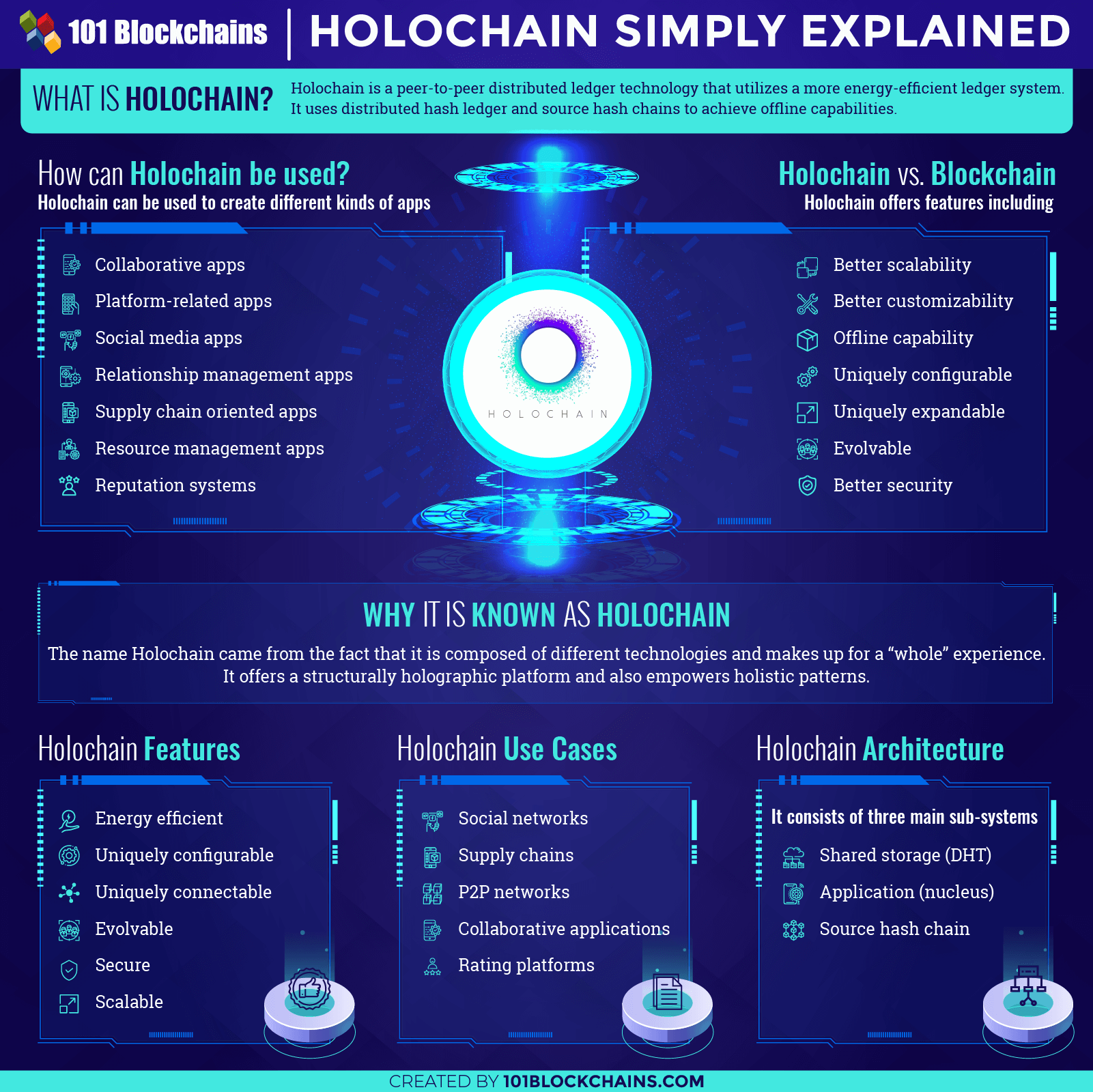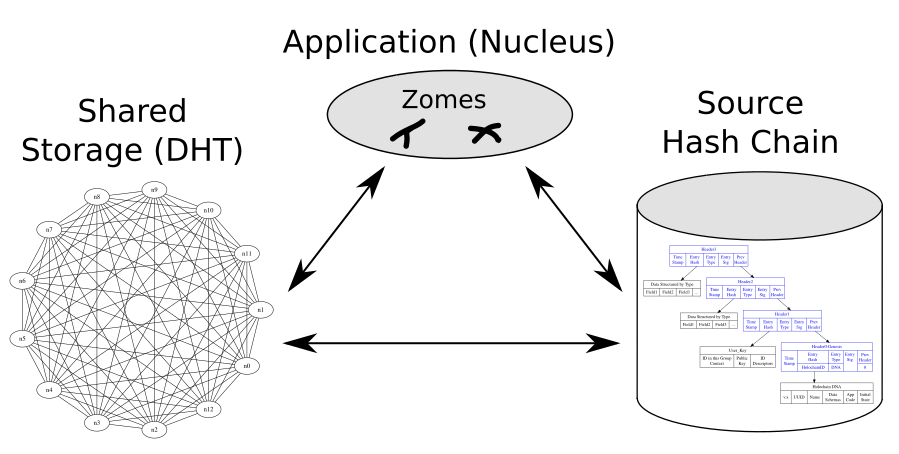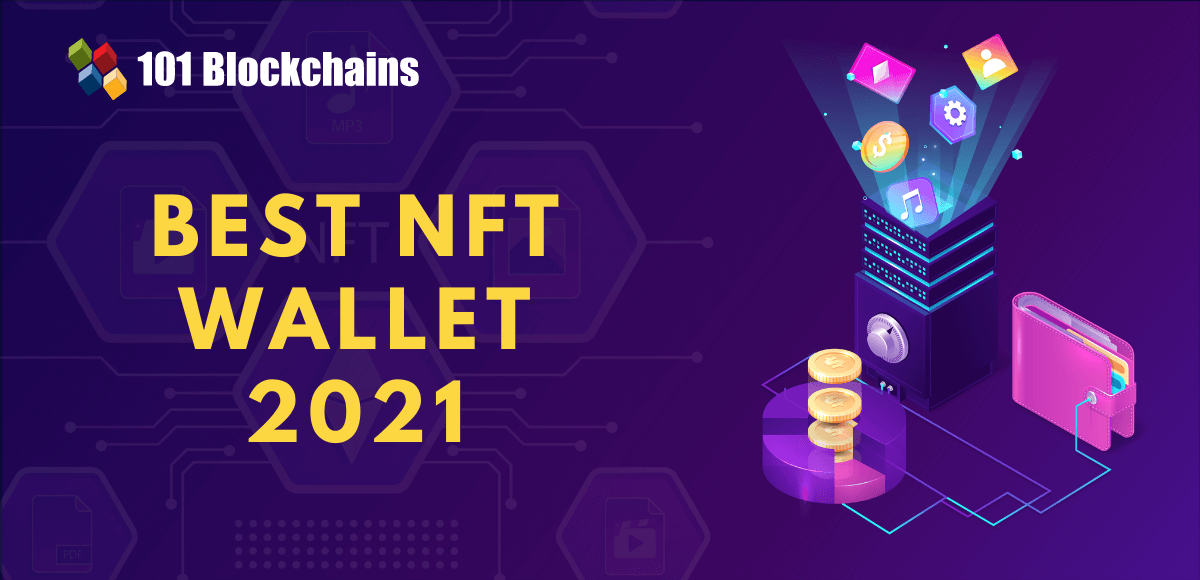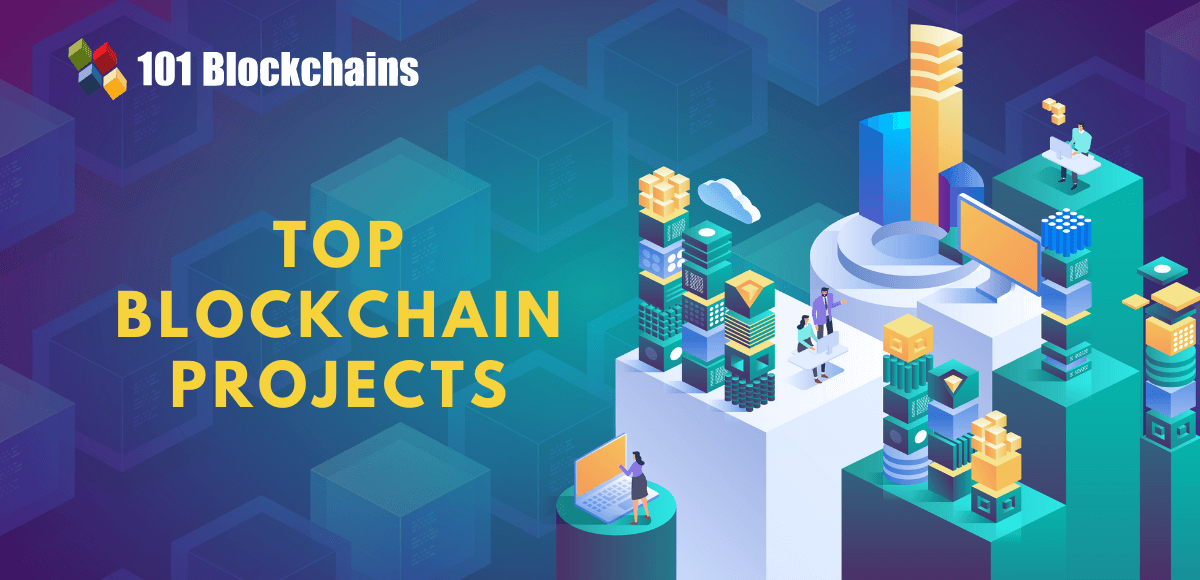Learn how blockchain truly works, master key definitions, and uncover what makes smart contracts so "smart." Dive into the fundamentals, gain valuable insights, and start your blockchain journey today!

- Reviews
101 Blockchains
- on September 19, 2019
Holochain Ultimate Guide: Better Technology Than Blockchain?
This article offers a detailed discussion on Holochain technology. Apart from the basic fundamentals, you will know about Holochain vs blockchain, Holochain applications, and its limitations.
Meet Holochain technology which sells itself as “thinking” outside the blocks. The evolution of blockchain continues to grow, and so do other similar technologies.
Holochain is a peer-to-peer distributed ledger technology. It works differently than blockchain and hence offers a unique value in the current market.
Build your identity as a certified blockchain expert with 101 Blockchains’ Blockchain Certifications designed to provide enhanced career prospects.
What is Holochain?
Holochain can be described as an open-source framework that facilitates a peer-to-peer network. It lets you build amazing applications that rely on distributed philosophy.
This might sound very similar to blockchain, but the difference is how they work internally.
The current generation of blockchain solutions relies heavily on energy. Take bitcoin; for example, it requires miners to validate the blocks. Proof-of-Work consensus algorithm involves a lot of computation power to solve cryptographic puzzles. This leads to a significant need in terms of energy — which is not ideal for mother nature. Holochain technology uses Go programming language, whereas the apps can be written in Lisp or JavaScript.
It is an energy-efficient ledger system that is agent-centric. This means that each agent can have a copy of the secure ledger and act independently. It can also interact with other network devices and provide a fully scalable distributed ledger solution. It is managed by Ceptr.
How Can You Use Holochain?
Holochain can be used for developing diverse distributed apps. The applications can be created for a wide range of usability. For example, the network is used for social media apps, governance, organization, and so on.
To give you a good idea about its usability, let’s go through the list of apps that you can create using Holochain technology.
- Collaborative apps
- Platform-related apps
- Social media apps
- Relationship management apps
- Supply chain oriented apps
- Resource management apps
- Reputation systems
And much more!
The wide use-case makes Holochain technology a valid alternative to Ethereum, which is also a dApp platform. It is not the only alternative Distributed Ledger technology (DLT) out there. We also covered Hashgraph which offers a viable alternative DLT solution over the blockchain.
How It Is Different from Blockchain? Holochain Vs. Blockchain
The critical difference between the two technologies is how they are utilized in the real-world. Both of them are peer-to-peer networks.
However, blockchain is ideal for systems that require global consensus. Holochain technology, on the other hand, is suitable for systems that can work without the need for a global agreement. The non-requirement of a global consensus brings a lot of benefits to the table, including better scalability, adaptability, efficiency, and extendibility.
Hash trees and hash tables are already part of computer science. They are data structures that are used effectively in different systems for ensuring data integrity. They were also evolved into various forms to adjust to the systems requirement.
It completely changes how each app can have its own network.
Get familiar with the terms related to blockchain with Blockchain Basics Flashcards.
Why It Is Known as Holochain?
Holochain name came from the fact that it is composed of different technology and makes up for a “whole” experience. It offers a structurally holographic platform and also empowers holistic patterns.
The three key cryptographic technologies used in the Holochain include the following:
- Hashchains
- Cryptographic singing
- Distributed Hash Table (DHT)
Please include attribution to 101blockchains.com with this graphic. <a href='https://101blockchains.com/blockchain-infographics/'> <img src='https://101blockchains.com/wp-content/uploads/2019/09/holochain-blockchain.png' alt='holochain='0' /> </a>
Holochain Features
We already have blockchain which is currently capable of providing a decentralized network. So, why do we need it at all? Let’s go through the key reasons below.
-
Energy efficiency
The current blockchain platforms require quite a bit of energy to operate. This, in the long run, can be a big issue for the planet earth where global warming is becoming a huge concern.
-
A Better New Model
Holochain technology introduces a better model which offers improved transfer and data storage. It can be used to enable edge devices, including smartphones, to act as a part of the network. The approach gives the network the ability to scale hugely and also enables any device or peer to become part of it.
-
Holochain Apps
Holochain applications are another big reason why we need them. The open-source framework approach is unique as it tries to bridge the gap between a public and private network.
Holochcain applications are distributed solutions that benefit heavily from the best of both worlds. This means that each dApp that you create on the chain has its customizable interoperable network.
Start your blockchain journey Now with the Enterprise Blockchains Fundamentals
-
Uniquely Configurable
Holochain approach is to provide each of its apps his/her network. This makes each network the ability to configure itself according to the requirements.
The unique approach means that each app can have its standards, protocols, and choice of the consensus algorithm. It also means that each app can alter network performance, including scalability, latency, or throughput.
Other key aspects that can be configured include resilience, governance, and privacy. This is why Holochain technology is a great decentralized app solution and not a network similar to Ethereum, NEO, or others.
-
Uniquely Connectable
So, how does Holochain technology work if the apps have their own unique distributed ledger? To stay connected, the different apps can bridge among themselves with the help of the native Application Programming Interface (API). The API is capable of providing a secure and profoundly integrated ecosystem.
This unique connectivity also means that the apps can work offline or when they are partitioned. In short, it makes them a clear winner when it comes to real-world applications. Every app can’t stay online every single time it needs to operate. Advertently, it also adds value to the most important industrial sectors, including energy, supply chain, or Internet of Things.
So, where does it lead us?
It leads us to microservice. Holochain relies heavily on microservices. This means that an app is a collection of standalone microservices. It improves the whole ecosystem as well with microservices can be used in other application or ecosystem.
Microservices are the future, and that’s why it is adopting microservices more than ever.
-
No Need to Learn Different Blockchain!
In an enterprise setup, it is hard to utilize or stick to a particular solution. Most of the enterprise use a mix of solutions for their different departments.
Holochain technology can completely eradicate the need for learning or using different blockchain. As Holochain is an open-source framework that offers DLT solutions, it can be used for different use-cases within the same organization.
You can configure your app according to the requirements. This means that you are free to choose the type of blockchain solution you want.
But that doesn’t mean that you cannot utilize it in an already established distribution network. To get started, you need to start learning Holochain and utilize it to expand certain aspects of a working system. This way, you can configure your network using Holochain and benefit from your customized decentralized solution.
You can also use the technique to replace your current systems with Holochain technology completely.
In short, Holochain technology is an excellent pick for service providers who want to have as much customizability as possible. This can help them provide a better solution to their customers with different requirements and needs.
New to Blockchain idea? Then, check out the Blockchain Training Free Course: All You Need to Know.
-
Evolvable
At the core, it depends on microservices. It makes the platform agile and fast development. It also means that the microservices can be bridged together.
The microservice approach is more future-proof and will help evolve the platform in the future. According to David Atkinson, it doesn’t rely on smart contracts, and that’s a good thing.
Smart contracts can be limiting in multiple ways. The number one limitation is the need for 100% accuracy. There is no need for Holochain apps to be so accurate from the start. It puts unnecessary stress on developers who want to get their apps out as soon as possible.
The technology evolvability is what makes it an ideal solution for the current marketplace, where agile development is the norm. It also makes it fit with the more demanding industries, including energy, food, or supply chain. In short, if an app is developed using Holochain, it can be evolved with time and requirements.
-
Secure
Holochain architecture enables apps to be more reliable compared to dApps. Each app is confined to its ecosystem or network, which makes it easy to handle the security part. Developers can set the restrictions.
It also means that data can be shared with other apps or networks using a more flexible security process. Developers can create those specific rules and enjoy the benefits of the application development kit provided by them.
It also has the means to handle the necessary security requirements. As a developer, you can get access to a bunch of functionalities. It utilizes cryptography to provide critical features such as tamper resistance, reliability, and data proof-of-authorship.
The security aspect also includes GDPR, which makes it ideal for global apps. Organizations can benefit from this immensely. This solves the issue of the blockchain GDPR paradox.
-
Scalable
Holochain also offers a highly scalable solution. As new apps can join the network, it can help grow the computational power of the network itself. It benefits from the unique architecture that it utilizes. Each node can contribute to computing power.
To make the apps scalable, it utilizes Rust, a programming language for WebAssembly compilation. The scalability is also dependent on the local number of peers. As the local number of peers is bound to be low, it means that it is more stable than ever with reduced network latency and sensitivity.
What Is Holochain Application? Holochain Applications Vs. dApps
With a complete understanding of Holochain features, it’s time to differentiate between Holochain and dApps.
dApps are the current trend in the market. Popular blockchains provide the ability to create dApps using their blockchain solution. But what makes it different from the Holochain apps? Let’s dive deep into it.
Don’t have much idea about dApps? Make sure to read this guide on what is dApp.
-
Scalability and Stability
dApps scalability depends on network capabilities, which can be limiting in many situations. Generally, Ethereum is a capable solution but is not the fastest one around. Also, there is no proper way to circumvent network scalability. This is especially true for public DLTs. For private networks, new peers can be added to improve the scalability of the network.
Holochain, on the other hand, has a clear advantage in this case. First of all, scalability can be gained easily as different dApps can communicate through the API, improving computing power. Also, the stability is bound to be better when it comes to Holochain applications have their local network with its pre-defined network requirements.
-
Adaptive and Evolvable
Holochain apps are more adaptive than dApps. Holochain apps architecture is designed to give powers to developers when building their local apps network. This means that they can set different network functionalities, including scalability, throughput, and so on.
In short, it is highly adaptable to the requirement. Not only that, Holochain apps can be evolved with time. In terms of dApps, most of the logic needs to be decided beforehand. Smart contracts, once written, are hard to change. This makes the life of developers hard — which is not ideal considering that the current developer community prefers agile development.
-
Online/Offline Functionality
Holochain applications are designed to work in both online and offline environments. In contrast, the dApps, both private and public, cannot work without connectivity to the main network. The inability to work offline is not desirable as many real-world operations, including supply chain need to work in situations where there is no internet connectivity.
-
Privacy and Access Control
Holochain apps have better privacy compared to public dApps. When compared to private dApps, it offers similar privacy options. Also, access control seems to be identical in both private dApps and Holochain. The difference is access control can be noticed when comparing public dApps and Holochain apps.
-
Mesh Network Friendly
Holochain networks are mesh network friendly. This means it is compatible with any form of radio signal. In return, it allows the apps to connect to any network signal or disconnect from others.
The ability to do it, in itself, gives the network true adaptability. In dApps, it is not possible as they are confined to their networks.
-
Modular Composability
Modular design gives Holochain apps to be more useful than dApps. With modularity and microservices, the different parts of the app can be used in other solutions, giving it modular composability.
The same cannot be done when it comes to smart contracts dApps.
-
Collaboration and Open
As it is an open-source platform, there is a clear advantage when it comes to private dApps and Holochain applications.
Aspiring to make a lucrative career as a blockchain developer but not sure how? Check the detailed guide Now on How To Become Blockchain Developer?
Holochain Use Cases
Holochain is a versatile framework. It also means that it can be used for a plethora of real-world use-cases.
- Social Networks: Social network is the best use-case of Holochain. It is useful considering that a social network can work without being connected, and the user can keep a copy of it locally.
- Supply Chains: Supply chains can also benefit immensely from Holochain. It can provide a unique way to handle the supply chain irrespective of organization, company, or geo-location.
- P2P Platforms: P2P platforms can take proper use of Holochain. Small communities can set it up according to their requirements. The P2P platform can also communicate with other networks and make proper use of Holochain capabilities.
- Collaborative Applications: Holochain is a great choice to build collaborative apps such as chats, scheduling, discussion, or even Wikis.
- Rating platforms: Rating platforms can be created, managed, and set up using Holochain.
This leads us to the end of Holochain use cases.
When NOT to Use Holochain?
So, we discussed the Holochain use-cases, but is there any instances where it is not beneficial? Yes, there is. Let’s go through them below.
- Private or Secret Data: If you are thinking of protecting your secure or private data, then you should avoid Holochain. It takes a lot of effort, private or secure, or even anonymous. If you know what you are doing, then you can go forward and use it. Otherwise, we recommend not to use it.
- Self-Exploration: If you are thinking of creating an Holochain application only for yourself, then it is not a good idea. It is not ideal for one-person use. However, if you want to use it to synchronize data across multiple devices, then it can be used.
- Huge Files: The last use-case where you should not use it is to store large files. That’s because each peer can have its copy of the ledger. If it is significant, then it defeats the purpose of the Holochain and makes the whole process painfully slow.
Holochain GitHub
Holochain is an open-source framework that means anyone can contribute to it.
If you are interested, check out their GitHub repository.
It has 103 repositories, out of which, Holochain-rust, Holochain-basic-chat, docs-pages, lib3h, and cryptographic-autonomy-license are pinned due to their importance.
The project is managed by nine people right now. So, if you make a change in their code, these nine people will finalize the change by either accepting or rejecting it.
Holochain is actively developed with its core repository Holochain-rust with already 13,000+ commits, 41 contributions.
The whole Holochain project is licensed under GPL-3.0.
Let’s go through the core repositories to get a better understanding.
- Holochain-rust → It is the core Holochain framework that utilizes rust programming language. It also offers container API.
- Holoscape → Holoscape is Holochain conductor end-user deployment. It also provides administration
- Holochain-basic-chat → example Holochain chat app
- Holochain-persistence → Used for storing and retrieving data locally
Human Internet- How Does Holochain Aim to Reach Its Goal?
Its purpose is to provide a more human internet with its approach. According to them, the whole world surrounds centralization, and that’s not good. Our relationships are surrounded by these corporations who dominate most of our moves — for example, people’s suggestions on whom to add.
Its future does look bright as it will consist of a distributed web where user anonymity will be maintained. The data shared among peers or communities is kept secure with their protocols and architecture.
If you inspire to learn more about their vision and mission, then read out Holochain whitepaper.
Holochain Architecture
Holochain architecture is interesting — it can be summed up as “shared DHT” where DHT stands for the distributed hash table. It overcomes the blockchain bottlenecks by keeping the key features of blockchain intact.
We can term it as “blockchain without bottlenecks.”
It achieves it with the help of Shared Data Integrity. It is a way of handling data in peer-to-peer systems where it is much more challenging to secure data compared to centralized data.
With shared data integrity, it offers robust data security without bringing limitations such as high computation demand.
The key component here is the distributed hash table (DHT), which provides great value to the ecosystem. It offers eventual consistency while ensuring that the data is propagated safely through the network. This way, each peer is accountable for his actions.
The architecture is also efficient as it ensures that the overhead is as feasible as possible. In fact, phones or other devices can join the network and improve computing power.
The Holochain Architecture (dApp architecture) consists of three main sub-systems. They are:
- Shared storage (DHT)
- Application (Nucleus)
- Source Hash Chain
Now, let’s go through each one of them below.
-
Application
Application is at the core of the whole idea. It glues together other aspects of the network. An application can be accessed using a browser, and the UI depends on how the developer designed it.
In the image above, you can see that it can access and store data from the DHT. It can also make use of its local source hash chain. The validation rules are provided by the application itself, which ensures that no data is tampered with, modified, or lost.
The applications are mainly written in Lisp and JavaScript.
-
Source Hash Chain
Source Hash Chain is what makes it possible for the application to work offline. It is a local ledger that each peer or person can own. The data stored in the local chain needs to be signed before it can be merged with the global shared DHT.
For example, if two parties interact with each other, they both need to validate it to their local source chain and then integrate it into the shared DHT.
This is a revolutionary idea considering that not everything requires to reach a consensus. If a social media Holochain app is running, then there is no need to validate every single validation with the whole set of peers. Local validation is more than enough, which can then be shared with the global DHT.
-
Shared Storage DHT
The last component, DHT, also plays a crucial role in making Holochain possible. DHT is already popular and is already used in file-sharing applications such as BitTorrent.
DHT enables peers to validate their own data using a cryptographic hash. This way, each piece of data is preserved with signature validated, confirming that the data has been committed to its local chain.
Multi-party transactions are also made possible using DHT. By doing so, it creates a crossing of chains, which further helps validate the whole set of transactions. Others can now publish your transactions, which makes them valid. The meta-data is frequently used to improve performance,
If the hash value is not matched during the crossing of chains, the transactions are invalidated by the network.
Curious to learn about blockchain implementation and strategy for managing your blockchain projects? Enroll Now in Blockchain Technology – Implementation And Strategy Course!
Conclusion
This leads us to the end of our Holochain Guide. Here, we discovered about Holochain, what makes it different from blockchain, and its key features. We also went deep into the Holochain architecture to understand how it works and what makes Holochain apps so great!
If you are interested in more blockchain fundamentals, make sure to check out the free blockchain course.
*Disclaimer: The article should not be taken as, and is not intended to provide any investment advice. Claims made in this article do not constitute investment advice and should not be taken as such. 101 Blockchains shall not be responsible for any loss sustained by any person who relies on this article. Do your own research!









